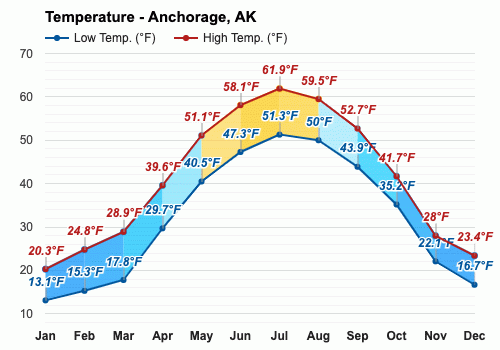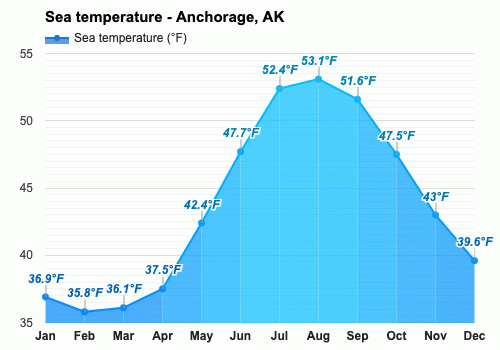Contents
- The climate of Anchorage
- The best time to visit Anchorage
- The worst time to visit Anchorage
- Spring weather in Anchorage
- Summer weather in Anchorage
- Autumn weather in Anchorage
- Winter weather in Anchorage
- Weather in January
- Weather in February
- Weather in March
- Weather in April
- Weather in May
- Weather in June
- Weather in July
- Weather in August
- Weather in September
- Weather in October
- Weather in November
- Weather in December
- Frequently asked questions
- Average temperature
- Average pressure
- Average wind speed
- Average humidity
- Average rainfall
- Average rainfall days
- Average snowfall
- Average snowfall days
- Average sea temperature
- Average daylight
- Average sunshine
- Average sunshine days
- Average UV index
- Average cloud cover
- Average visibility

Climate and monthly weather forecast
The climate of Anchorage
Throughout the year, Anchorage sees a wide range of temperatures, with averages fluctuating between 13.1°F (-10.5°C) and 61.9°F (16.6°C). It is noteworthy that temperatures in winter dip significantly, with the coldest month of December witnessing a chill low of 13.1°F (-10.5°C). In contrast, the July summer offers the highest warmth peaking at 61.9°F (16.6°C).
Humidity in Anchorage remains relatively high year-round, with a slight decrease observed during the drier spring and summer months, where it drops to as low as 68%. Precipitation levels also vary greatly throughout the year. Although rainfall is prevalent almost all year round, its intensity varies. The heaviest rainfall occurs in September with an average of 1.93" (49mm), while the drier times of the year, come in May with an average rainfall of just 0.55" (14mm).
Uniquely, Anchorage receives a significant amount of snowfall, with the heaviest snowfalls typically occurring in December and reaching as high as 5.51" (140mm). The longest days experienced are in June with approximately 19.2 hours of daylight. It is during these months that the city basks in the maximum sunshine of 11.7 hours.
The best time to visit Anchorage
The worst time to visit Anchorage
Spring weather in Anchorage
Summer weather in Anchorage
Autumn weather in Anchorage
Winter weather in Anchorage
Weather in January
Weather in February
Weather in March
Weather in April
Weather in May
Weather in June
Weather in July
Weather in August
Weather in September
Weather in October
Weather in November
Weather in December
Published by: Weather U.S. | About Us
Data Sources | Weather Forecasting & Climate
Frequently asked questions
What month is the coldest?
What is the most humid month?
How much does it rain?
When does it snow?
How much does it snow?
What is the month with the coldest ocean?
When is the lowest UV index?
When is Daylight Saving Time (DST) in Anchorage?
What is the least humid month?
What is the driest month?
What are the months with the most sunshine?
When it does not snow?
When are the longest days in Anchorage?
What is the month with the highest UV index?
What are the warmest months?
When is the ocean warmest?
What is the rainiest month?
When does it snow the most?
What is the month with the shortest days?
What is the month with the least sunshine in Anchorage?

Average temperature
Anchorage, AK
The warmest month (with the highest average high temperature) is July (61.9°F).
The month with the lowest average high temperature is January (20.3°F).
The month with the highest average low temperature is July (51.3°F).
The coldest month (with the lowest average low temperature) is January (13.1°F).

Average pressure
Anchorage, AK
- Average pressure in January:
29.7"Hg - Average pressure in February:
29.82"Hg - Average pressure in March:
29.76"Hg - Average pressure in April:
29.82"Hg - Average pressure in May:
29.93"Hg - Average pressure in June:
29.9"Hg
- Average pressure in July:
29.96"Hg - Average pressure in August:
29.86"Hg - Average pressure in September:
29.74"Hg - Average pressure in October:
29.7"Hg - Average pressure in November:
29.67"Hg - Average pressure in December:
29.67"Hg
The month with the highest atmospheric pressure is July (29.96"Hg).
The months with the lowest atmospheric pressure are November and December (29.67"Hg).

Average wind speed
Anchorage, AK
- Average wind speed in January:
5.5mph - Average wind speed in February:
5.2mph - Average wind speed in March:
5.1mph - Average wind speed in April:
5.2mph - Average wind speed in May:
5.2mph - Average wind speed in June:
4.8mph
- Average wind speed in July:
4.5mph - Average wind speed in August:
4.7mph - Average wind speed in September:
5.2mph - Average wind speed in October:
5.5mph - Average wind speed in November:
6.3mph - Average wind speed in December:
6.2mph
The windiest month (with the highest average wind speed) is November (6.3mph).
The calmest month (with the lowest average wind speed) is July (4.5mph).

Average humidity
Anchorage, AK
The months with the highest relative humidity are January, February and March (86%).
The month with the lowest relative humidity is May (68%).

Average rainfall
Anchorage, AK
- Average rainfall in January:
0.63" - Average rainfall in February:
0.71" - Average rainfall in March:
0.71" - Average rainfall in April:
0.67" - Average rainfall in May:
0.55" - Average rainfall in June:
0.75"
- Average rainfall in July:
1.22" - Average rainfall in August:
1.57" - Average rainfall in September:
1.93" - Average rainfall in October:
1.65" - Average rainfall in November:
1.02" - Average rainfall in December:
1.18"
The wettest month (with the highest rainfall) is September (1.93").
The driest month (with the least rainfall) is May (0.55").

Average rainfall days
Anchorage, AK
- Average rainfall days in January:
7.8 days - Average rainfall days in February:
7 days - Average rainfall days in March:
8.5 days - Average rainfall days in April:
10.8 days - Average rainfall days in May:
11.5 days - Average rainfall days in June:
12.5 days
- Average rainfall days in July:
14.6 days - Average rainfall days in August:
17.9 days - Average rainfall days in September:
16 days - Average rainfall days in October:
15.2 days - Average rainfall days in November:
9.5 days - Average rainfall days in December:
8.6 days
The month with the highest number of rainy days is August (17.9 days).
The month with the least rainy days is February (7 days).

Average snowfall
Anchorage, AK
- Average snowfall in January:
3.15" - Average snowfall in February:
4.45" - Average snowfall in March:
4.13" - Average snowfall in April:
2.09" - Average snowfall in May:
0.12" - Average snowfall in June:
0"
The month with the highest snowfall is December (5.51").
The months with the least snowfall are June, July and August (0").

Average snowfall days
Anchorage, AK
- Average snowfall days in January:
9.3 days - Average snowfall days in February:
11.4 days - Average snowfall days in March:
10.1 days - Average snowfall days in April:
5.4 days - Average snowfall days in May:
0.3 days - Average snowfall days in June:
0 days
- Average snowfall days in July:
0 days - Average snowfall days in August:
0 days - Average snowfall days in September:
0.3 days - Average snowfall days in October:
2.4 days - Average snowfall days in November:
8.5 days - Average snowfall days in December:
11.6 days
The month with the highest number of snowfall days is December (11.6 days).
The months with the least snowfall days are June, July and August (0 days).

Average sea temperature
Anchorage, AK
The best month for swimming (with the highest average sea temperature) is August (53.1°F).
The coldest month (with the lowest average sea temperature) is February (35.8°F).

Average daylight / Average sunshine
Anchorage, AK
- Average daylight in January:
6h and 4min - Average daylight in February:
9h and 1min - Average daylight in March:
11h and 5min - Average daylight in April:
14h and 5min - Average daylight in May:
17h and 4min - Average daylight in June:
19h and 1min
- Average daylight in July:
18h and 2min - Average daylight in August:
15h and 4min - Average daylight in September:
12h and 5min - Average daylight in October:
10h and 0min - Average daylight in November:
7h and 2min - Average daylight in December:
5h and 4min
The month with the longest days is June (Average daylight: 19h and 12min).
The month with the shortest days is December (Average daylight: 5h and 36min).
- Average sunshine in January:
4h and 0min - Average sunshine in February:
5h and 2min - Average sunshine in March:
7h and 1min - Average sunshine in April:
8h and 4min - Average sunshine in May:
11h and 4min - Average sunshine in June:
11h and 4min
- Average sunshine in July:
11h and 1min - Average sunshine in August:
9h and 5min - Average sunshine in September:
7h and 4min - Average sunshine in October:
6h and 1min - Average sunshine in November:
4h and 4min - Average sunshine in December:
3h and 5min
The months with the most sunshine are May and June (Average sunshine: 11h and 42min).
The month with the least sunshine is December (Average sunshine: 3h and 48min).

Average sunshine days
Anchorage, AK
- Average sunshine days in January:
16.9 days - Average sunshine days in February:
12.8 days - Average sunshine days in March:
16 days - Average sunshine days in April:
12.9 days - Average sunshine days in May:
16.3 days - Average sunshine days in June:
14.1 days
- Average sunshine days in July:
14.2 days - Average sunshine days in August:
11.4 days - Average sunshine days in September:
11.1 days - Average sunshine days in October:
13.4 days - Average sunshine days in November:
15 days - Average sunshine days in December:
15.5 days
The month with the most sunshine days is January (16.9 days).
The month with the least sunshine days is September (11.1 days).

Average UV index
Anchorage, AK
The months with the highest UV index are June and July (UV index 4).
The month with the lowest UV index is February (UV index 1).

Average cloud cover
Anchorage, AK
The month with the most cloud cover is December (Cloud cover 47).
The month with the least cloud cover is May (Cloud cover 38).

Average visibility
Anchorage, AK
The months with the highest visibility are January, February, April, May, June, July, August, September, October, November and December (6mi).
The month with the lowest visibility is March (5mi).